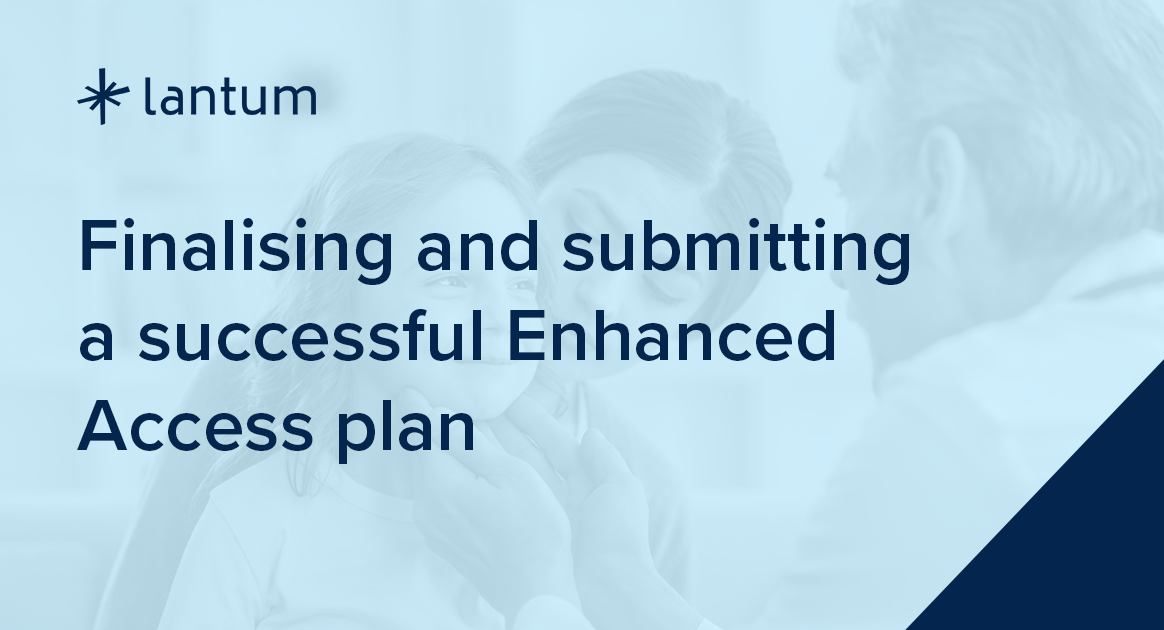Finalising and submitting a successful Enhanced Access plan
Enhanced Access drafts have been submitted and plans are being lined up to start implementing new services, however, lots of questions remain around the practical aspect of Enhanced Access, and what it’ll look like when confronted with the day-to-day realities of patient needs and clinical capacity.
Our panel of experts recently came together to talk about what Enhanced Access looks like in their experience and how clinicians can embrace the new changes. Keep reading for four key takeaways from our webinar, or watch the full recording here.
1. Enhanced access isn’t a one-size-fits-all solution, and should be adapted and localised for your patient’s unique needs.
Dr Krisham Bhanot, a GP Partner, ICS Digital Clinical Lead, and ICP Cardiology Clinical Lead ran local surveys and found that services like diabetic clinics and wound care were needed in his region, however, he also emphasised the importance of flexibility when it comes to offering the services your community needs.
As Nicole Atkinson, NHS Confed Primary Care Medical Advisor, put it: “Don’t panic, because we all know that primary care can turn on a dime.” She pointed to the COVID-19 response as an example, “It doesn’t need to be perfect on day one. This will be a bit of a learning process.”
If you still have questions about what Enhanced Access should look like day-to-day, Nicole also pointed to the NHS’s frequently asked questions document.
2. Practices and PCNs can overcome staffing challenges by using Enhanced Access slots to offer more ARRS services like physiotherapy, mental health, and more.
Dr Neil Modha, Primary Care Clinical Director and Chair of the Greater Peterborough Network Federation, recommended asking key questions like:
- What do you want for your practice?
- What do you want for your population?
Having been part of a pilot project for Enhanced Access for a few years, he saw success with a mix of staff including healthcare assistants, clinicians and other roles like physiotherapists.
Nicole agreed, saying: “There’s a national expectation you’ll see ARRS roles stepping forward to support this delivery.”
Dr Ishani Patel, a clinical GP and co-founder of Lantum, mentioned that staff banks also offer organisations the opportunity to access a wider range of locum GPs to help fill gaps in their rota.
3. Understanding your population’s health needs is a combination of health data from larger organisations and listening to practices at the local level.
When it comes to delivering Enhanced Access services, understanding health data and what your local population needs is critical.
Nicole points out that it’s tricky to collate information from a blend of sources, and organisations should adopt a wrap-around infrastructure that can support networks to understand what’s going on in their communities. Clinics on the ground can add their own unique perspectives to build a bigger picture.
Dr Bhanot worked with the Kent Public Health Observatory in 2019 to get data that went down to the PCN level on population health, which helped to identify areas for improvement. Public health consultants at the ICS level can be major drivers for understanding population health data.
4. Enhanced Access isn’t just a service shift, it’s a culture shift that can bring change and digital innovation.
Not only is Enhanced Access moving from on-the-day appointments and overflow demand to long-term models, it also requires networks to ask who’s going to be clinically leading services and how they’re going to be held accountable, says Dr Patel.
All members of the panel agreed that it’s rare for things go right on the first try, and commissioners need to understand the need for flexibility as PCNs work toward this culture shift.
On a practical level, Dr Bhanot is trialling software that looks at PCN- and practice-level data. He recommends trying to not see Enhanced Access as a loss of control or something that’s being forced on clinics.
“If it is here and it’s going to happen, make the most of it. Be innovative and bold and see what comes out of it,” he says. “There is an opportunity here to do things in a way you might not have considered before, and provide care for patients in a different way.”
If you’re looking for experienced support when it comes to organising and staffing your Enhanced Access services, Lantum can help.
Lantum’s all-in-one rota management tool, Connected SchedulingTM, helps you:
- Get full visibility into data and analytics, enabling you to quickly identify problem areas and dedicate resources to resolving them
- Fill rotas up to three months in advance, addressing gaps with plenty of time to spare
- Share staff and fill rota gaps across your PCN through Lantum’s staff pool feature — your ICS may have already adopted this, so ask if you’re not sure
- Offload clinical governance checks to us, so you can be sure all clinicians are CQC-approved and ready to work.
To chat with one of our team members about your Enhanced Access services and how Lantum can help, book a demo.



